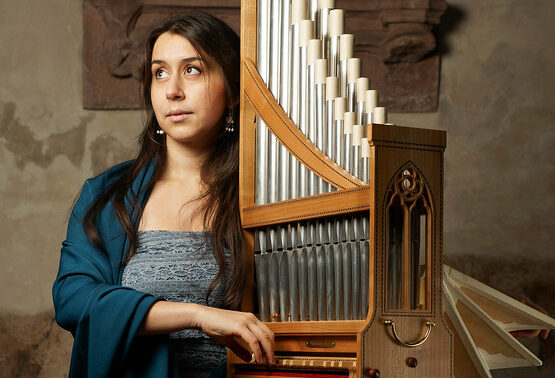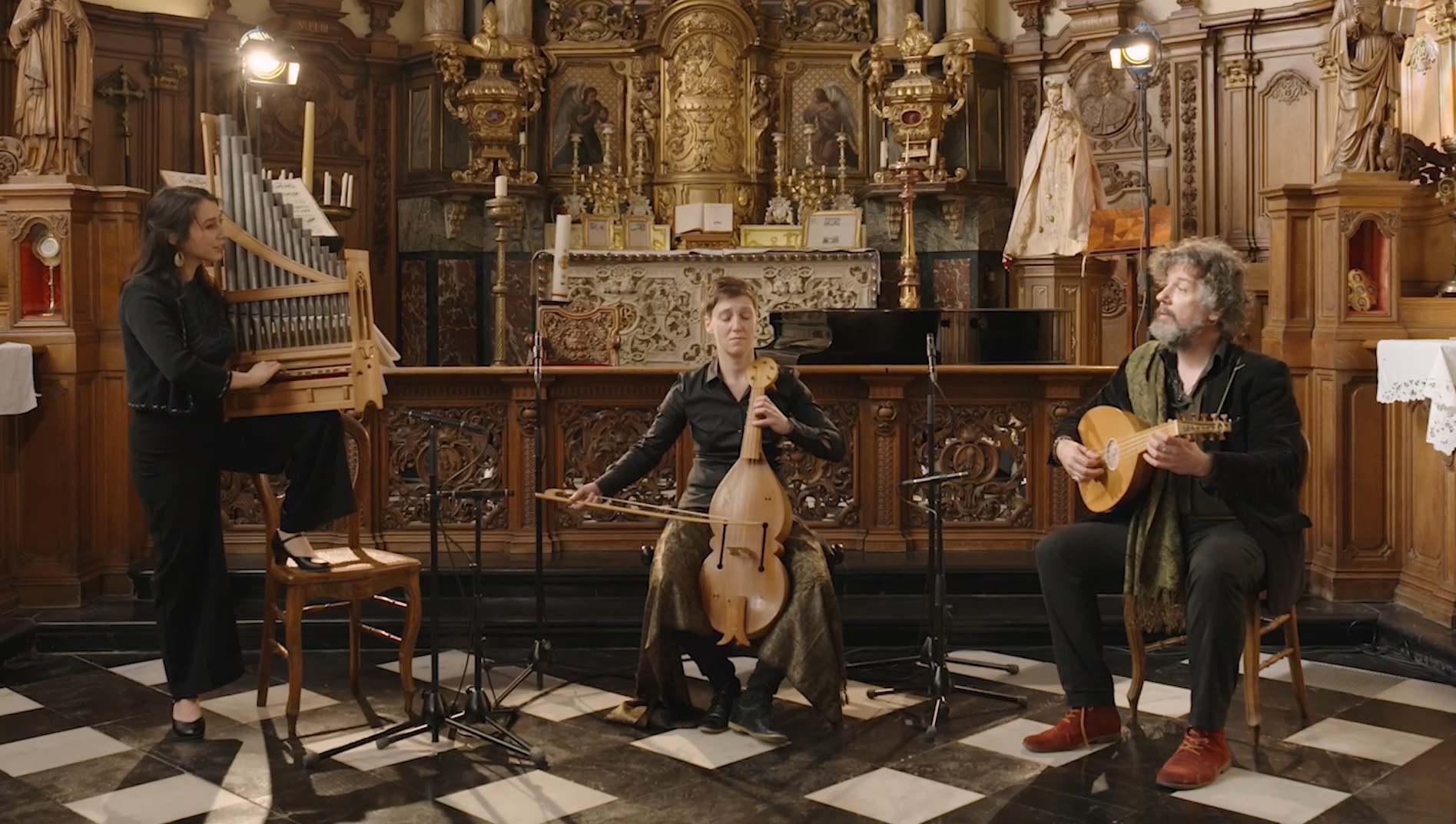The Cinematheque | Map
Catalina Vicens, Medieval portative organ & artistic direction; Servir Antico
In this concert film, Servir Antico tell the story of Christine de Pizan (1364 – ca.1430), a revolutionary woman who questioned the treatment of women and their prescribed place and role in society in her magnum opus, The Book of the City of Ladies. Though it was heavily criticized at the time, the poet Martin Le Franc, unlike most other men, championed her cause and helped spread awareness of the importance of women as active and multifaceted citizens. The programme is in praise of womankind, with works from the Ars Subtilior, compositions by Baude Cordier and Soulage, and anonymous compositions alongside works by Binchois and Dufay. Catalina Vicens and Servir Antico present this exquisite concert, which was recorded in the medieval chapel of Notre-Dame- à-la-rose in Belgium.
“An exquisite ode to womankind at the Bach Fest… Here’s to high praise of womankind, from a group that brilliantly bridges the distant past with the present.” – Janet Smith, Stir Magazine
This concert is generously supported by Elaine Adair
PROGRAMME
Baude Cordier (fl. early 15th c.)
Belle, bonne, sage, plaisante et gente
Guillaume Dufay (1437-1474)
Ave regina caelorum
Solage (fl. late 14th c.)
Calextone qui fut dame terrouse
La vision de Platon
Text: Martin Le Franc (1410-1461 )
‘Le Champion des Dames’, 1441
Music: Michaël|le Grébil Liberg
Guillaume Dufay (1437-1474)
L’alta belleza tua, virtute, valore
La mode des Romains orguilleux
Text: Martin Le Franc (1410-1461 )
‘Le Champion des Dames’, 1441
Music: Michaël|le Grébil Liberg
Nicolas Grenon (ca. 1375 – 1456)
La plus belle et doulce figure
Ma mère: reine couronnée dès l’instant où elle fut née
Text: Christine de Pizan (1364-ca.1430) de ‘La Mutation de Fortune’, 1403
Musique: Michaël|le Grébil Liberg
Michaël|le Grébil Liberg (*1973)
Belle, l’an se renouvelle
Anonyme (mid 15th century)
Environ la Saint Valentin
Gilles Binchois (ca.1400-1460)
Anguished grief
Catalina Vicens (*1983)
Christine’s Lament
Text: Christine de Pizan, ‘Deuil angoisseux’ from ‘Hundred Ballads’
Mutation: Becoming a man
Text: Christine de Pizan, from ‘La Mutation de Fortune’, 1403
Music: Nolwenn Le Guern et Michaël|le Grébil Liberg
Anonymous (late 14th c.)
Lunne Plaine
Man and Woman: Joined in their diversity
Text: Martin Le Franc, de ‘Le Champion des Dames’, 1441
Music: Michaël|le Grébil Liberg
Johannes Ghiselin (fl. 1497-1507)
O florens rosa
Hayne van Ghizeghem (ca.1445 – 1476/97) / Bartolomo degli Organi (1474-1539)
De tous biens plaine
Programme Notes
Christine de Pizan was born in Venice in 1364. At a young age, she moved with her family to Paris, when her father, Thomas de Pizan, was appointed astrologer to the court of Charles V of France. The young woman held her father in very high regard, and he, defying the conventions of the time, placed great importance on the education of his daughter, giving her opportunities normally only offered to men. When speaking of her mother, Christine identifies with the wisdom, versatility and beauty of motherhood, incarnated in the figure of Mother Nature: a woman, a creator of life. Her words of admiration and praise can be heard in Mother: crowned queen from the moment she was born, extracted from her Livre de la Mutation de Fortune (Book of the Mutability of Fortune) from 1403, in which she allows us to enter into the intimate world of her personal life. After entering into a loving marriage to Étienne Castel while young and welcoming three children into the world, she becomes a widow in 1387 at the age of 22, the same year in which she loses her beloved father.
In the Middle Ages, a widow who did not either quickly remarry or enter a convent was viewed with suspicion, and yet Christine resists remarrying and tries to build up sufficient independent income to maintain her social rank. Afflicted by depression and immeasurable personal pain, she puts pen to paper, and writes Cent Ballades (A Hundred Ballads), in which she lays out for the world her mourning at the loss of her husband, the depth of her isolation and the fragility of her position as a woman in a hostile aristocratic court. Deuil angoisseux (Anguished Grief), one of the poems in this collection, served as inspiration for the composer Gilles Binchois (ca. 1400-1460), and for the new rendering of Christine’s Lament by Catalina Vicens.
Having chosen the profession of a man of letters, socially Christine had effectively ‘become’ a man (de femelle devins masle). She bears the weight of social judgment that ensues but outweighs it with the force of her own self-validation, projecting an identity that today might be called ‘transgender.’ This identity statement is vividly portrayed in the sensual words of Christine’s Mutation: becoming a man from La Mutation de Fortune.
Christine de Pizan thus became the first European woman to earn a living as a professional writer. Her passion for learning was immense and her output was incredibly diverse, embracing scholarly works on philosophical, political, moral, didactic, religious and even military subjects. One of her main interests, however, was history. Although this subject was not yet considered a fundamental discipline in university training, it was to be an important intellectual interest leading to the creation of Le Livre de la Cité des Dames.
Christine writes what we would know today as ‘Herstory,’ i.e., history emphasizing the role of women. By doing so she creates a work that will serve as a potent and lasting weapon in the defence of women against misogyny and for the protection of their right to fulfill a diversity of roles in society.
Against the backlash of harsh critiques, a male poet, Martin le Franc (1410-1461), comes to her defence in the opening years of a centuries-long polemical debate known as the querelle des femmes (“the debate about women” or “the woman’s question”). In his defense of womankind entitled Le Champion des Dames (ca.1442), the protagonist enters into a debate over the true nature of women, their capabilities, and whether they should be permitted to study, write, or govern in the same manner as men. Taking examples from history, he reminds us of Plato’s vision. The Greek philosopher considered that women should study to train and improve their intellectual capacities, and that they could serve many diverse roles in society, serving as magistrates or fighting in wars if they wished to do so. He also warns us of the devastating impact of Roman culture in the spread of misogyny.
The Book of the City of Ladies is a strong critique of the established popular belief, famously propagated by Jean de Meun’s Roman de La Rose, that men are inherently superior to women.
In Christine’s and Martin’s vision, the feminine and masculine are complementary and fluid, as proclaimed in the excerpt Homme et femme, conjoins in leur diversité (Man and woman, conjoined in their diversity) from Martin le Franc’s Le Champion des Dames, in which both identities are seen as fundamental to each individual. The complementary nature of the feminine and masculine can also be heard in Lunne plaine, a piece that uses Nature to symbolize this relationship.
* * *
This production was filmed at two historical sites that provide an interesting perspective on the City of Ladies project. The chapel and the gardens of the historic Hôpital Notre Dame à la Rose in Lessines, Belgium, active until 1980, was one of the oldest hospitals to remain uniquely in the hands of religious women. It was founded by a 13th-century noblewoman, Alix de Rosoit, as a place to give medical care to the poor and indigent of the region. The Augustine nuns in charge of the hospital have displayed some quite visionary attitudes to the subject of gender roles through the art that they have commissioned. One striking example is a painting of Christ with a female body, which shows how these women have been able to seek out diverse representations and to think beyond established norms, even while members of a religious community.
The Erasmus House in Brussels, former residence of one of the most influential humanists of the Renaissance, served as a harmonious backdrop for the spoken texts taken from Christine de Pizan’s and Martin Le Franc’s oeuvre, as well as for the commentaries provided by Dr. Hélène Haug, scientific advisor of the museum and by Catalina Vicens, artistic director of Servir Antico.

Catalina Vicens, Medieval portative organ & artistic direction
Born in Chile and currently residing in Italy, Calatina Vicens is recognized by the international press as “one of the most interesting musicians in the field of early music.” Her approach to historically-informed performance and musicological research has led her to become one of the most versatile and sought-after historical keyboard performers and teachers of her generation.
In 2013 she founded ensemble Servir Antico, with whom she aims to shed light on the lesser-known repertoire and intellectual heritage of the Humanistic Period (13th-16th century) while using the concert stage to share with the audience the voices of these visionaries of the past, and to also using it to amplify new voices. In 2021, Ms. Vicens was named curator of the Tagliavini Collection in Italy, one of the largest historical keyboard collections in Europe, and artistic director of Museo San Colombano in Bologna. She is also harpsichord/research lecturer at the Royal Conservatory of Brussels (Belgium) and Visiting Professor of Harpsichord at Oberlin Conservatory (USA), amongst many other prestigious appointments.

Servir Antico
Servir Antico is an ensemble inspired by the legacy of Renaissance Humanism (an intellectual/cultural movement from the 13th to 16th century). The group was founded by Catalina Vicens, a musician and researcher specializing in Medieval and Renaissance repertoires who unites the power of acclaimed vocal and instrumental soloists (possessing extensive experience in historically-informed performance) with the desire to create an environment of respect and communication.
Servir Antico’s programs are designed to not only bring an almost forgotten repertoire to contemporary audiences, but to also immerse that audience in a multi-sensorial experience. Poetry, dramaturgy, and musical text transport the listener back to an era of dazzling creation, introspection and beauty. With the music and texts as a point of departure, projects of social engagement are an intrinsic part of each program.


